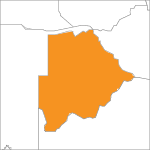 The high prevalence of undernutrition in children in Botswana—31 percent under 5 are stunted, 11 percent are underweight, and 7 percent are wasted—is a great concern to the government. Twelve thousand children under 14 years of age live with HIV, while the country has one of the highest adult HIV prevalence levels in the world. Infants born to mothers living with HIV have poorer growth and higher morbidity and mortality than those born to mothers who are not infected with HIV. Children infected with HIV can experience reduced appetite, food intake, and nutrient absorption, resulting in a further weakened immune system and malnutrition. Botswana also has an estimated 60,000 orphans due to AIDS. These children are more likely to be underweight and stunted due to poor health and nutrition because they are prone to be poor, receive less care, and may be HIV-infected.
The high prevalence of undernutrition in children in Botswana—31 percent under 5 are stunted, 11 percent are underweight, and 7 percent are wasted—is a great concern to the government. Twelve thousand children under 14 years of age live with HIV, while the country has one of the highest adult HIV prevalence levels in the world. Infants born to mothers living with HIV have poorer growth and higher morbidity and mortality than those born to mothers who are not infected with HIV. Children infected with HIV can experience reduced appetite, food intake, and nutrient absorption, resulting in a further weakened immune system and malnutrition. Botswana also has an estimated 60,000 orphans due to AIDS. These children are more likely to be underweight and stunted due to poor health and nutrition because they are prone to be poor, receive less care, and may be HIV-infected.
To meet these challenges, Botswana is improving operational efficiencies in its Ministry of Health (MOH). This includes merging two MOH nutrition programs—the Nutrition Rehabilitation Program, established with support from the U.S. President’s Emergency Plan for AIDS Relief (PEPFAR), with the UNICEF-supported community-based management of acute malnutrition program, into the Integrated Management of Acute Malnutrition and Underweight in Children and Adolescents (IMAMU) program. IMAMU includes two Centres for Child and Adolescent Nutrition (CCANS), in Gaborone and Francistown.
In 2015, the MOH asked USAID/Botswana and FANTA to assess the quality of implementation by the CCANs, as well as the referral networks between health centers and the CCANs. The main goals of the assessment are to help the MOH:
- Improve interactions between CCANs and referral networks
- Identify optimal CCAN referral models for potential replication
- Evaluate CCAN implementation to determine what is working well and what can be improved
- Formulate recommendations for CCAN service quality improvements to improve client outcomes
The findings and recommendations from FANTA’s assessment are expected to help the MOH optimize service delivery for malnourished children, in particular those infected with HIV, by identifying improved models for CCAN organization and implementation, uncovering best practices and remedies for challenges within the context of IMAMU referral systems, and highlighting areas of CCAN operations that are ripe for improvement.


